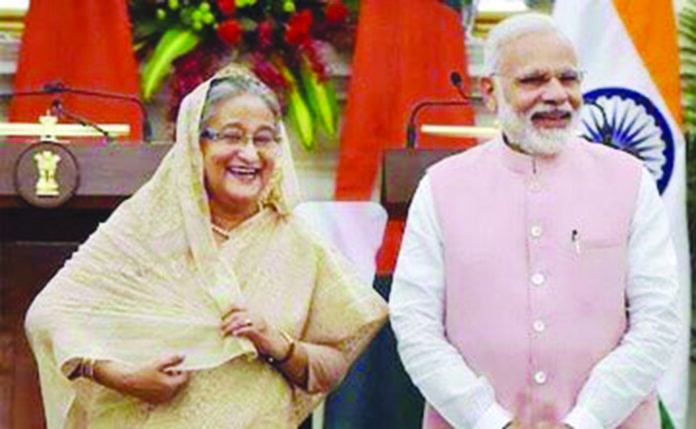After almost three years, Bangladesh Prime Minister Sheikh Hasina is going to Delhi again on a state visit on September 5 (today). Prime Minister Sheikh Hasina’s visit is very significant in India-Bangladesh bilateral relations. The Modi government also wants to give special importance to this visit. Because in the changing geopolitical situation, New Delhi considers Dhaka its most ‘trusted friend’. On September 6, the two Prime Ministers will have a private meeting and a delegation level meeting. Sheikh Hasina will address major business meetings like the Indian Chamber of Commerce the next day, September 7. She will present the picture of how both parties can benefit if Indians invest in Bangladesh. The next day she will return to Dhaka via Ajmer Sharif.
Why is this visit of Prime Minister Sheikh Hasina so important? The temporary power shortage in Bangladesh is going to end as Bangladesh’s largest thermal power project ‘Maitri’ is going to be inaugurated during her visit to India. Despite considerable ‘pressure’ from the Bangladesh government, the Teesta water distribution agreement could not be implemented mainly due to the objection of West Bengal Chief Minister Mamata Banerjee. This time there will be significant progress, if not total.
The demand for wheat in Bangladesh is increasing. In this situation, the Modi government has given permission to export wheat through the Hili border in Dinajpur. It should be remembered that this will be her last visit to India before the upcoming elections in Bangladesh. As a result, India will not return Sheikh Hasina empty-handed.
During Sheikh Hasina’s visit this time, there is a bright possibility of finalizing the trade agreement called ‘CEPA’ (Comprehensive Economic Partnership Agreement) between the two countries. Prime Minister Sheikh Hasina recently approved the draft of this agreement in the cabinet meeting. Now she is just waiting for India to agree on this. It is being touted as a ‘landmark’ agreement for free and duty-free trade in hundreds of goods between India and Bangladesh. If this is the joint testing service, one-stop service will be launched.
To get raw materials and technical assistance quickly and cheaply, India will have to enter into some kind of financial agreement, which is not dependent on dollars. Bangladesh and India are gradually moving in that direction, only at this moment the leaders and ministers of the two countries need to be helpful to each other in tackling the crisis.
It will increase investment. As a result, exports will increase by $3-$5 billion beyond the current $1.28 billion. After the signing of the CEPA agreement, if the trade barriers are removed, the import picture of Bangladesh will also change. As most of India’s products and services are compatible with Bangladesh’s economy and culture, and due to low transportation costs and time savings, Bangladeshi importers will turn to India instead of Far Eastern countries for the same products. Then the amount of imports from India will increase. In that case, the current import of $7 billion will increase by $4-$7 billion.
Before Sheikh Hasina’s visit, a ministerial meeting of the Joint River Commission (JRC) was held in Delhi on August 25. On August 23, JRC secretary-level meeting was held. It discussed the water sharing agreement of Manu, Dharla, Khoai, Muhuri, Gomti and Dudhkumar rivers.
In this, the issue of finalizing the Memorandum of Understanding (MoU) on the withdrawal of Kushiara river water becomes important. Bangladesh wants to use Kushiara water to facilitate the cultivation of 5 thousand acres of land in Sylhet. This would require India’s permission to withdraw water from the same river.
Besides, the Ganga water sharing agreement will expire in 2026. There is supposed to be a joint survey for maximum utilization of this common river water. After more than a century, the meeting of the Joint Rivers Commission (JRC) of the two countries is being held in Delhi. The matters agreed by the JRC in terms of water sharing or water management of several important common rivers of the two countries will be fulfilled in the meeting of the two Prime Ministers.
This time, the question is – Will the Chief Minister of West Bengal, who has held back the Tista Agreement, come and meet Sheikh Hasina in the capital during her visit to Delhi? The central government of India has invited her as per rules. Meanwhile, Prime Minister Sheikh Hasina gave a message to the country’s Hindu community on Janmashtami before her visit to India. She said, ‘Don’t think of yourself as a minority. All people have equal rights in Bangladesh regardless of caste and religion.’
The Bangladesh government has requested $4.5 billion in assistance from the IMF. Economists say that the increase in the price of oil and gas, machinery and raw materials in the international market has created a huge pressure on the country’s foreign exchange reserves. Bangladesh approached the IMF donors to handle that pressure. Last year, Bangladesh’s foreign exchange reserves were $45.5 billion, but by July 20, they had dropped to $37.67 billion. In addition to the increase in the prices of fuel oil, gas, and food products in the international market, imports have increased a lot.
Bangladesh has not faced such economic problems with foreign exchange for the last decade, because both remittances and exports have done more or less well during this period. But now due to the situation that has developed in the world, there is a negative impact on remittances. Exports are good, but the rate at which imports have increased has created pressure on the balance of payments. Bangladesh’s infrastructure is improving rapidly. Now it’s time to set up various industries.
In that case, in order to get raw materials and technical assistance quickly and cheaply, India will have to enter into some kind of financial agreement, which is not dependent on dollars. Bangladesh and India are gradually moving in that direction, only at this moment the leaders and ministers of the two countries need to be helpful to each other in tackling the crisis.























